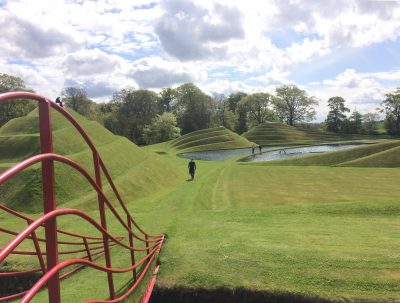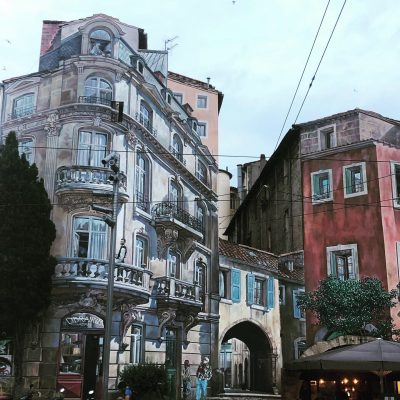 Photo: The spectacular Charles Jencks landform at Jupiter Artland, Edinburgh.
Photo: The spectacular Charles Jencks landform at Jupiter Artland, Edinburgh.
Here in Melbourne, Australia, restrictions are easing after lockdown #4 and our international borders will be closed until next year. That doesn’t need explanation. Traveler friends around the world have been staying at home since early 2020. Those of us who are art-lovers have been spoilt by galleries and museums throughout these difficult times: virtual tours, conversations, education, so much knowledge shared. One could sit in front of the computer all day, but I’m not good at sitting still for long.
In the past, I’ve written about cities I’ve visited, the textures of landscapes, history, cultures and, particularly the art. As I (we) can’t travel, I’m writing this blog about a couple of my much-loved cities. Hopefully, you’ll make yourself comfortable, pour a nice wine, and vicariously travel with me. Enjoy!
Starting with EDINBURGH, SCOTLAND with it’s never-changing beautiful face, rich in everything art, famous for its annual performance, Fringe and literary festivals. I stay with dear friends whose hospitality and learned appreciation for their home is contagious. Each day starts with one of my favourite sprightly walks, up Arthurs’s Seat, overlooking the city of Edinburgh and beyond.
At the other end of the day, we regularly drink at The Sheep Heid Inn, Duddingston. Dating back to the 14th Century, The Sheep Heid is Scotland’s oldest pub, boasting famous patrons from times gone by including Bonnie Prince Charlie, writer Robert Louis Stevenson and poet Robert Burns.





Photos: The walk starts around Dunsapie Loch; towards the peak of Arthur’s Seat; along the pathway: the small track down to Duddingston Village; The Sheep Heid.
On past visits, I’ve become aware of Scotland’s vast history of female artists, as well as seeing wonderful contemporary works by women. My last trip, I was introduced to painter Victoria Crowe (London born 1945,) whose breadth of creativity includes interiors, landscapes, portraits and still life. As her subject changes, so does her palette, the impact of light, as her painting techniques become familiar.
Born in London (1945), Victoria Crowe made Edinburgh’s Pentland Hills her home from the late 1960’s. The seasons and cold climate play a role in many of her works. Her art was further impacted by travels to Italy, particularly the early Renaissance works. What is enticing about Crowe’s work is the awareness of its passages, seemingly a reflection of those movements within in her life, in the aptly titled exhibition, “Victoria Crowe, 50 years of Painting”.





Photos: Four from Victoria Crowe’s exhibition including Portrait of pioneering Psychoanalyst, Dr Winifred Rushforth and Near Rialto, Venice; stroll the city’s Dundas Street for a variety of contemporary glass and art.
Art ‘of all sorts’ abounds in Edinburgh:





Photos: Pleasance is one of many hubs at the Edinburgh Fringe Festival; Nathan Coley’s “Everything is going to be alright” across the facade of the Scottish National Gallery of Modern Art; sculptural stones in the old dressing rooms at Dovecot Tapestry Studio and Galleries (formerly Victorian Baths); weavers work on the floor at Dovecot: The Queen’s Gallery.
SEVILLE in sunny SPAIN.
There’s everything to love about Spain, I’ve been a few times and can’t name a favourite place or city. I could start with the food! Like everything Spanish, it explodes with colour and textures. The people too are vibrant, as are the street sights, the music, architecture, history and climate, hence sunny Spain. On my last trip, we visited friends in Seville – capital of the Andalusia region – my first ‘taste’ of its delights.





Photos: mouth-watering jamon, carved from the bone; Al fresco dining – in the gardens alongside Plaza de España , “Cheers” Richard. Victoria, spoilt for choice at Chiva restaurant (the best hospitality). Salads and sausages beside the Canal De Alfonso XIII; “Cheers” Emilie.
Strolling Seville, there’s much to absorb. As an Australian, the tiling around Spain is always enticing, something we don’t see at home. Their colours of yellow and blue, also represented in the yellow and white architecture, are pretty against the skies. Look up, down, over there! Let the photos do the walking.





Photos: Postcards from Seville; Plaza de España, loads of loveliness.





Photos: Look up as you wander; fishing under the Puente de Isabel II; view of the city from one of the undulating walkways of Metropol Parasol (known as “the Mushrooms”, Las Setas), built 2011.
Formerly a Convent built 1594, Museo de Bellas Artes de Sevilla (Museum of Fine Arts) has an extensive collection housed in five rooms: 15th century Sevillian painting and sculpture; Renaissance; Mannerism; Naturalism: Murillo and Sevillian Baroque. There’s much to see as your eyes roam the decorative arches, walls, ceilings, before taking in the breadth of art history and works. I’ll have to return to absorb and learn more. Here’s a small sampling.





Photos: Sculpture by Italian artist of the Florentine school, Pietro Torrigiano. He was important in introducing Renaissance art to England, but his ‘violent temper’ impacted his success. He died in Seville in 1528; Retrato de señora y caballero orantes (Portrait of a praying lady and gentleman) by Francisco Pacheco, a Spanish painter and teacher whose textbook “Art of Painting” was an important study source of 17thC practice in Spain; along the cloisters in the (former) Convent; furniture and wall sculptures; Nicoloso Francisco was an Italian painter and sculptor, based in Seville, his Virgen con el Niño (Virgin and child).
On my last trip to Europe, I visited MONTPELLIER in SOUTHERN FRANCE, staying with Melbourne friends in their apartment. It felt immediately like a ‘happy home’, not just because of their generous hospitality, but also the compact size of this old University town. From Montpellier’s heart, Place de la Comedie Square, with its theatres, old buildings and people-watching, it’s easy to wander the charming narrow streets, finding ‘little places of interest’. The tram system is efficient, but as a walker, I was happy to stroll around Montpellier’s medieval history for hours. We dined al fresco for lunch and dinner and, on one evening were treated to an outdoor music recital.
The University’s Faculty of Medicine, is a fascination, not just visually, but historically. Originally St. Bendict’s Monastery founded in 1364, it became the Faculty of Medicine in 1795. The Faculty contains a library of 900 manuscripts, 300 incunabula and 10,000 volumes printed before the 18th century. I can’t imagine the awe and excitement of today’s medical students, walking through those looming wooden doors, knowing it’s so old that Nostradamus studied there. (I’ve read this great astrologer and prophesier had a few ‘run ins’ with the learned faculty members and was asked to leave, not achieving his Doctorate.)





Photos: The Montpellier Aqueduct – Les Arceaux ; Looking up to the apse of St Peter’s Basilica (first stone laid in 1364, consecrated in 1373); entrance hall to Faculty of Medicine; one of the many lists of Bienfaiteurs (Benefactors) from as early as 1180 Guilhem VIII; the Law Courts Building.
Strolling Montpelier, enjoying the street sights and lifestyle.





Photos: Eye-pleasing trompe l’oeil; these bicycles were attached to walls around various parts of the city; leisurely summer reading.





Photos: “Look up!”; Oh yes, we enjoyed the outdoor dining in summer’s evening light.
We roamed a couple of art galleries, but Montpellier’s Musée Fabre is it’s ‘gem’ – considered one of the finest art museums in Europe, with a collection ranging from Renaissance through to contemporary and present day works.





Photos: Stairway up to one of elegant gallery spaces in Musée Fabre; traditional & contemporary art and sculpture; detail from Montpellier artist Frédéric Bazille’s (1868) Vue de Village; portrait of Fernande Olivier by Dutch painter Kees van Dongen (Fauvism, 1905). Fernande, herself a French artist and model, seems to have been much loved and admired. Pablo Picasso painted more than 60 portraits of her. Twenty years after their relationship she published a book about their time together. Picasso hired lawyers to suppress publication. Ultimately only six articles were published, but apparently Fernande lived well off the financial rewards.
Edinburgh, Seville, Montpellier. Three abundantly colourful and beguiling cities. It’s challenging right now, not being able to travel, to stroll familiar main streets, explore winding village paths, gape in galleries, sip coffee while people-watching. Most importantly, missing the excitement of booking flights, those months of forward planning to see friends ……. and then, there you are again. Together, “as if it was yesterday”, dining under the night skies, laughing, seated at a favourite restaurant, tasting the deliciousness of foods and local wines. ….. catching-up.
So near but so far. We’ll be back! Photo: Montpellier – look closely. This romantic building is, in fact,
Photo: Montpellier – look closely. This romantic building is, in fact,
an apartment block covered in trompe l’oeil art.
© 2021 Text and photographs Pamela Reid/tPRo